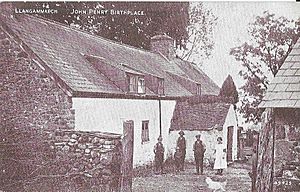John Penry facts for kids
John Penry (born 1563, died 1593) was an important Welsh figure from the time of Queen Elizabeth I. He was a Protestant who believed in separating from the main church. He is known as Wales' most famous Protestant martyr, meaning he died for his strong religious beliefs.
Contents
John Penry's Early Life
John Penry was born in 1563 in Brecknockshire, Wales. His family farm, Cefn Brith, is thought to be his birthplace. His parents were Meredydd Penry and Eleanor Godley.
He started studying at Peterhouse, Cambridge, in 1580. At first, he might have been a Roman Catholic. However, he soon became a Protestant with strong Puritan ideas. After getting his first degree, he moved to St Alban Hall, Oxford. He earned his master's degree there in 1586. John Penry did not become a priest. Instead, he was allowed to preach at the university.
Preaching and Writing
There is not much information about John Penry's preaching trips in Wales. These trips likely happened for a few months in 1586 or in the autumn of 1587.
In 1562, a law was passed to translate the Bible into the Welsh language. The New Testament was printed in Welsh in 1567. But there were very few copies, barely enough for each church. John Penry was upset by this.
Speaking Out for Wales
In 1587, Penry published a book called The Æquity of an Humble Supplication. In this book, he asked for more to be done to teach the Gospel in Wales. Archbishop Whitgift was angry because Penry's book seemed to criticize the church. Whitgift had Penry brought before a special court and put in prison for about a month.
After he was released, Penry married a woman from Northampton. He lived there for several years. With help from Sir Richard Knightley, he set up a printing press. This press was very busy for almost a year, starting in late 1588.
The Secret Printing Press
The printing press moved around to different places. It was in East Moulsey, then Fawsley, then Coventry, and other places in Warwickshire. Finally, it was in Manchester, where it was found and seized in August 1589.
On this press, Penry printed his own books. These included Exhortation to the governours and people of Wales and View of... such publike wants and disorders as are in the service of God... in Wales. The press also printed the famous Martin Marprelate writings. These were a series of secret pamphlets that criticized the Church of England.
In January 1590, his house in Northampton was searched, and his papers were taken. But John Penry managed to escape to Scotland. While in Scotland, he published more writings. He also translated a religious book called Theses Genevenses.
Return to England and Final Days
John Penry returned to England in September 1592. He joined a group of separatists, also called Brownists, in London. He chose not to take a leadership role in the group. However, after their ministers were arrested, he became the regular preacher.
He was arrested in March 1593. This happened after a local vicar recognized him in Ratcliff. He was put in Poultry Compter prison. Officials tried to find a reason to charge him with a serious crime that could lead to his death.
The Charge and Execution
They could not find a clear reason. So, they charged him with sedition. This charge was based on a rough draft of a petition he had written to Queen Elizabeth I. The language in the draft was strong and critical, but it had never been officially given to the Queen or published.
John Penry was found guilty on May 21, 1593. He was put to death on May 29 at a place called St Thomas-a-Watering. This happened at an unusual time, 4 p.m. He was not allowed to see his wife, Eleanor, or their four young daughters before he died. Their daughters were named Deliverance, Comfort, Safety, and Sure-Hope. The order for his execution was signed by his old enemy, Archbishop Whitgift, first.


